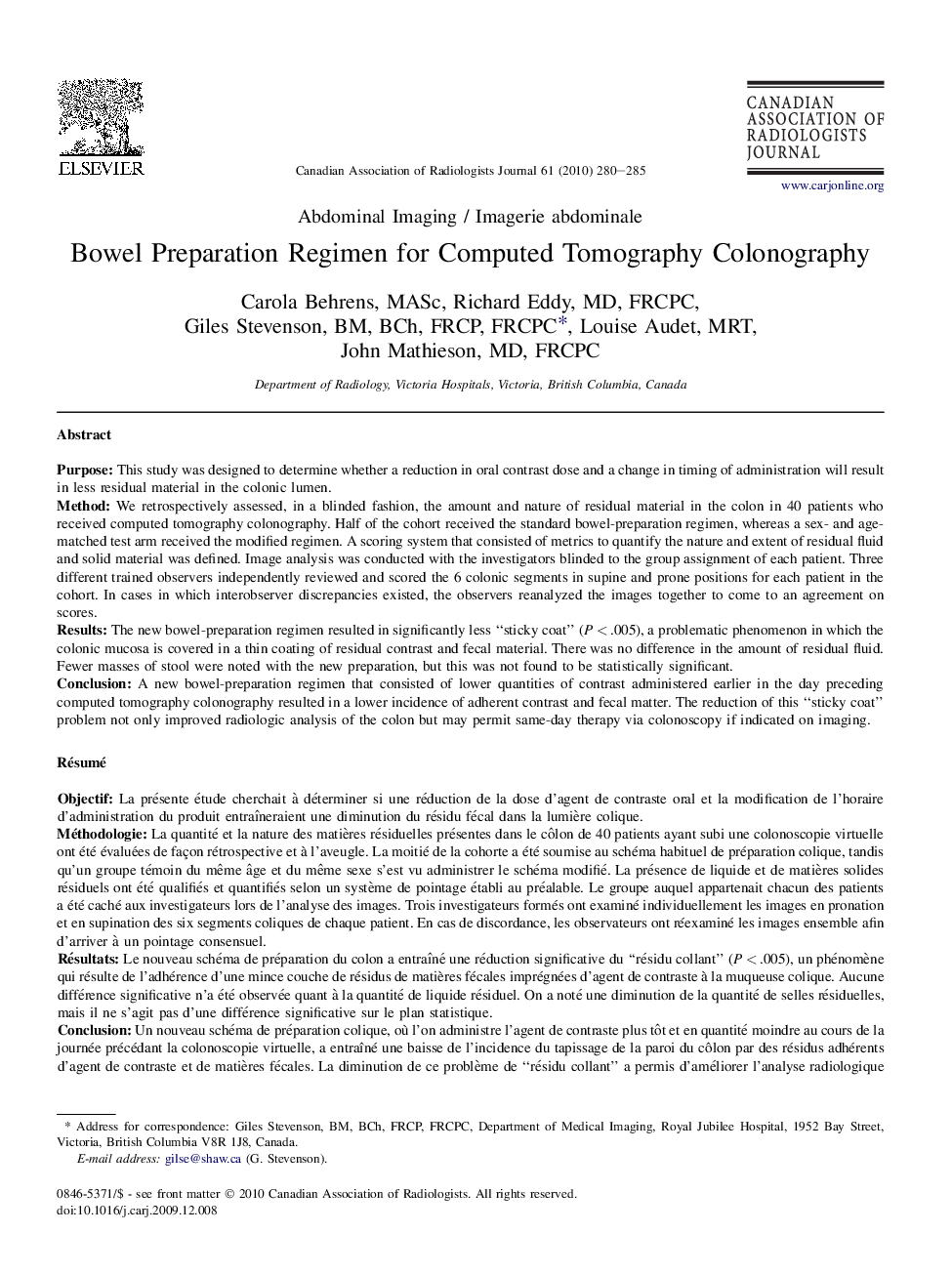| Article ID | Journal | Published Year | Pages | File Type |
|---|---|---|---|---|
| 4220700 | Canadian Association of Radiologists Journal | 2010 | 6 Pages |
PurposeThis study was designed to determine whether a reduction in oral contrast dose and a change in timing of administration will result in less residual material in the colonic lumen.MethodWe retrospectively assessed, in a blinded fashion, the amount and nature of residual material in the colon in 40 patients who received computed tomography colonography. Half of the cohort received the standard bowel-preparation regimen, whereas a sex- and age-matched test arm received the modified regimen. A scoring system that consisted of metrics to quantify the nature and extent of residual fluid and solid material was defined. Image analysis was conducted with the investigators blinded to the group assignment of each patient. Three different trained observers independently reviewed and scored the 6 colonic segments in supine and prone positions for each patient in the cohort. In cases in which interobserver discrepancies existed, the observers reanalyzed the images together to come to an agreement on scores.ResultsThe new bowel-preparation regimen resulted in significantly less “sticky coat” (P < .005), a problematic phenomenon in which the colonic mucosa is covered in a thin coating of residual contrast and fecal material. There was no difference in the amount of residual fluid. Fewer masses of stool were noted with the new preparation, but this was not found to be statistically significant.ConclusionA new bowel-preparation regimen that consisted of lower quantities of contrast administered earlier in the day preceding computed tomography colonography resulted in a lower incidence of adherent contrast and fecal matter. The reduction of this “sticky coat” problem not only improved radiologic analysis of the colon but may permit same-day therapy via colonoscopy if indicated on imaging.
RésuméObjectifLa présente étude cherchait à déterminer si une réduction de la dose d'agent de contraste oral et la modification de l'horaire d'administration du produit entraîneraient une diminution du résidu fécal dans la lumière colique.MéthodologieLa quantité et la nature des matières résiduelles présentes dans le côlon de 40 patients ayant subi une colonoscopie virtuelle ont été évaluées de façon rétrospective et à l'aveugle. La moitié de la cohorte a été soumise au schéma habituel de préparation colique, tandis qu'un groupe témoin du même âge et du même sexe s'est vu administrer le schéma modifié. La présence de liquide et de matières solides résiduels ont été qualifiés et quantifiés selon un système de pointage établi au préalable. Le groupe auquel appartenait chacun des patients a été caché aux investigateurs lors de l'analyse des images. Trois investigateurs formés ont examiné individuellement les images en pronation et en supination des six segments coliques de chaque patient. En cas de discordance, les observateurs ont réexaminé les images ensemble afin d'arriver à un pointage consensuel.RésultatsLe nouveau schéma de préparation du colon a entraîné une réduction significative du “résidu collant” (P < .005), un phénomène qui résulte de l'adhérence d'une mince couche de résidus de matières fécales imprégnées d'agent de contraste à la muqueuse colique. Aucune différence significative n'a été observée quant à la quantité de liquide résiduel. On a noté une diminution de la quantité de selles résiduelles, mais il ne s'agit pas d'une différence significative sur le plan statistique.ConclusionUn nouveau schéma de préparation colique, où l'on administre l'agent de contraste plus tôt et en quantité moindre au cours de la journée précédant la colonoscopie virtuelle, a entraîné une baisse de l'incidence du tapissage de la paroi du côlon par des résidus adhérents d'agent de contraste et de matières fécales. La diminution de ce problème de “résidu collant” a permis d'améliorer l'analyse radiologique du côlon et de pratiquer une coloscopie conventionnelle le jour même, s'il y a lieu, en fonction des résultats de l'imagerie.
